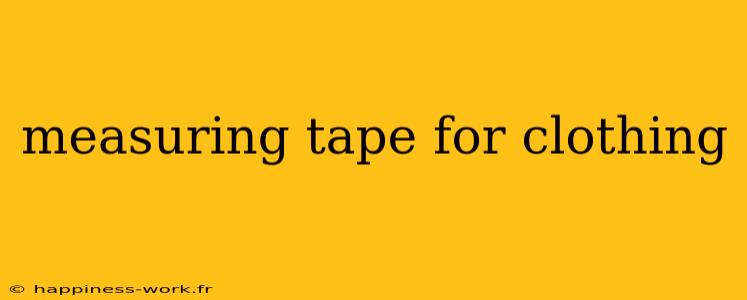Measuring tape is an essential tool in the world of fashion, sewing, and tailoring. Whether you're designing a custom outfit, altering a garment, or simply shopping for the perfect fit, a measuring tape can provide you with the precision you need. In this article, we'll cover everything you need to know about measuring tapes for clothing, including how to use one effectively and the different types available.
What is a Measuring Tape?
A measuring tape is a flexible ruler used to measure size or distance. It's typically made of cloth, plastic, or fiberglass and is often marked with both metric and imperial units. For clothing, you'll generally want a measuring tape that is flexible and easy to use.
Types of Measuring Tapes
When choosing a measuring tape for clothing, consider the following options:
1. Sewing Measuring Tape
- Description: Usually made of soft fabric or plastic, this type is flexible and can easily conform to body shapes.
- Use Case: Ideal for taking body measurements, such as bust, waist, and hip.
2. Retractable Measuring Tape
- Description: This type is housed in a casing and retracts with a button.
- Use Case: Convenient for quick measurements; often used by tailors and construction workers alike.
3. Tailor’s Measuring Tape
- Description: Typically longer than standard measuring tapes and sometimes includes additional features, like a sliding marker.
- Use Case: Excellent for professional tailors, especially for larger projects.
How to Use a Measuring Tape for Clothing
Taking accurate measurements can be daunting. Here’s a step-by-step guide:
Step 1: Gather Your Tools
- Materials Needed: A soft measuring tape, a notebook or smartphone for taking notes, and perhaps a second person to help.
Step 2: Wear Fitted Clothing
- Make sure you wear fitted clothes or just undergarments, as bulky clothing can distort measurements.
Step 3: Measure Key Areas
Here are common measurements you should take, along with tips for accuracy:
- Bust: Measure around the fullest part of the bust, ensuring the tape is parallel to the ground.
- Waist: Measure around the natural waistline, usually located just above the belly button.
- Hips: Measure around the fullest part of the hips.
- Inseam: Measure from the top of your inner thigh to your ankle.
Tip: It helps to take multiple measurements and average them for accuracy.
Common Questions About Measuring Tape for Clothing
How do I maintain my measuring tape?
- Answer: Store your measuring tape in a cool, dry place, away from direct sunlight. Avoid stretching or crumpling it to maintain its accuracy. Proper maintenance can extend the lifespan of your measuring tape.
How do I read a measuring tape?
- Answer: Measuring tapes usually have inches marked with half-inch increments. Metric tapes are marked in centimeters and millimeters. Familiarize yourself with both units for versatility.
Additional Note: Understanding how to read fractions can enhance your ability to take precise measurements. For example, knowing that 1/2 inch is the same as 1.27 cm can be helpful when converting between measurement systems.
Added Value: Tips for Buying the Right Measuring Tape
When selecting a measuring tape, consider the following factors to ensure you choose the right one for your needs:
- Material: Opt for a tape made of durable material like fiberglass or a strong plastic. This ensures longevity.
- Length: Standard measuring tapes are usually around 60 inches (or 150 cm), which is generally sufficient for clothing measurements. However, for larger sewing projects, consider a longer tape.
- Readability: Look for tapes with clear markings and numbers for ease of reading.
Conclusion
A measuring tape is an indispensable tool for anyone involved in clothing design, alteration, or shopping for the right fit. By understanding its use and the different types available, you can ensure that you get accurate measurements every time. Remember to choose the right tape for your needs, maintain it properly, and you’ll be well on your way to mastering the art of measurement.
This article was inspired by various questions and answers found on WikiHow, which provides extensive insights into clothing measurement techniques. Proper credit is given to the original authors for their contributions.
